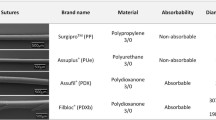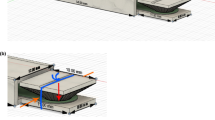Summary
The abdominal fascia incisions of 133 rabbits were closed either with plain gut, chromic gut, PGA or polyester threads. The breaking strength of the wounds were determined tensiometrically at different time intervals and the tissue was examined histologically.
For a three-week period the strength of the abdominal wall depends significantly on the intactness of the threads. PGA produces minimal inflammatory reactions, but loses its strength after a fortnight. Since longitudinal incisions are endangered by severe muscle pull, this material cannot be recommended because of the possibility of wound disruption and the formation of hernias. The loss of strength of catgut plain and catgut chromic starts later. Catgut causes inflammatory reactions within the wound area leading to loss of strength of the sutured tissue. Thus incisions of the abdominal fascia should not be closed with catgut. The non-resorbable suture material polyester shows satisfactory strength and minimal tissue reaction. As long as there is no synthetic suture material with mild tissue reaction and late resorption the fascial closure should be sutured with polyester.
Zusammenfassung
Es wird über die Reißfestigkeit von Wunden der Abdominalfaszie bei Kaninchen nach Naht mit verschiedenen Nahtmaterialien (Catgut plain, Catgut chromiert, PGS and Polyester) berichtet. Bis zum 21. postop. Tag hängt die Festigkeit der Bauchdeckennarbe noch entscheidend vom Vorhandensein der intakten Fäden ab. PGS zeichnet sich durch besondere Gewebeverträglichkeit aus, verliert aber bereits nach dem 14. postop. Tag seine gesamte Festigkeit. Da an Längsschnitten der Abdominalfaszie große Kräfte angreifen, kann es zu deren Naht nicht empfohlen werden. Es besteht unter Umständen die Gefahr der postoperativen Wundruptur und Bildung von Narbenhernien. Der Festigkeitsverlust von Catgut plain und von Catgut chromiert tritt erst zu einem späteren Zeitpunkt ein. Catgut verursacht aber Entzündungsreaktionen in der Wundumgebung, die zum Festigkeitsverlust des Gewebes führen. Auch diese Nahtmaterialien können zum Verschluß der Abdominalfaszie nicht empfohlen werden. Polyester, ein nicht resorbierbares Nahtmaterial, garantiert ausreichende Festigkeit, ist gewebefreundlich und kann deshalb zur Naht der Abdominalfaszie verwendet werden.
Similar content being viewed by others
Literatur
ANSCOMBE, A.R.: The use of DexonR absorbable suture material in general surgery. Int. Surg.57, 887 - 888 (1972)
ATZLER, E.: Leistung mechanischer Arbeit.In: Landois-Rosemann, Physiologie des Menschen. München-Berlin-Wien: Urban & Schwarzenberg 1950
BARY, S., v., MARX, F.J., SCHAUDIG, A.: Erste Erfahrungen mit einem neuen absorbierbaren synthetischen Nahtmaterial (DexonR). Chirurg43, 271–274 (1972)
BONKE, S., SCHERER, H.J., FISCHER, M.: Erfahrungen mit dem synthetischen, absorbierbaren Nahtmaterial DexonR. Münch. med. Wschr.115, 1851–1853 (1973)
BÖTTGER, G., VORSTER, C.: Die postoperative Bauchwandruptur. Chirurg40, 80–85 (1969)
BURKHARDT, K.: Die Wunddehiszenz nach Laparotomien. Brun's Beitr. klin. Chir.216, 633–639 (1968)
CASSAU, D., SIEWERT, R.: Die vollständige Wundruptur in neuerer Sicht. Chirurg38, 381–385 (1967)
DAUME, E.: Erfahrungen mit einem synthetischen resorbierbaren Nahtmaterial Polyglykolsäure) bei gynäkologischen und geburtshilflichen Operationen. Geburtsh. u. Frauenheilk.32, 702–707 (1972)
DOUGLAS, D.M.: The healing of aponeurotic incisions. Brit. J. Surg.40, 79–84 (1952)
ECHEVERRIA, E.A., JIMENEZ, J.: Evaluation of an absorbable synthetic suture material. Surg. Gynec. Obstet.131, 1–14 (1970)
DRYE, J.C.: Intraperitoneal pressure in the human. Surg. Gynec. Obstet.87, 473–475 (1948)
EFRON, G.: Abdominal Wound Disruption. Lancet I, 1287–1293 (1965)
EILERT, J.B., BINDER, P., McKINNEY, P.W., BEAL, J.M., CONN, J.: Polyglycolic acid synthetic absorbable sutures. Amer. J. Surg.121, 561–564 (1971)
GALLITANO, A.L., KONDI, E.S.: The superiority of polyglycolic acid sutures for closure of abdominal incisions. Surg. Gynec. Obstet.137, 794–796 (1973)
GERHART, A., SCIOR, H.: Über die Häufigkeit der Ruptur von Laparotomiewunden. Zbl. Chir.83, 730–736 (1958)
HERNÁNDEZ-RICHTER, J.: Klinische und experimentelle Untersuchungen über die postoperative Wundruptur. Habilitationsschrift, Köln 1964
HERRMANN, J.B., KELLY, R.J., HIGGINS, G.A.: Polyglycolic acid sutures. Arch. Surg.100, 486–490 (1970)
HOWES, E.L.: Strength studies of Polyglycolic acid versus catgut sutures of the same size. Surg. Gynec. Obstet.137, 15–20 (1973)
KATZ, A.R., TURNER, R.J.: Evaluation of tensile and absorption properties of polyglycolic acid sutures. Surg. Gynec. Obstet.131, 701–716 (1970)
LICHTENSTEIN, I.L., HERZIKOFF, S., SHORE, J.M., JIRON, M.W., STUART, S., MIZUNO, L.: The dynamic of wound healing. Surg. Gynec. Obstet.130, 685–690 (1970)
MANN, L.S., SPINAZZOLA, A.J., LINDESMITH, G.G., LE VINE, M.J., KUCZEREPA, W.: Disruption of abdominal wounds. J.A.M.A.180, 1021–1023 (1962)
NELSON, C.A., DENNIS, C.: Wound healing: Technical factors in the gain of strength in sutured abdominal wall wounds in rabbits. Surg. Gynec. Obstet.93, 461–467 (1951)
RAHMANN, M.S., WAY, S.: Polyglycolic acid surgical sutures in gynaecological surgery. J. Obstet. Gynec. Brit. Com.79, 849–851 (1972)
SCHUMANN, H.D., NITZSCHE, L.: Wunddehiszenz nach Laparotomien. Zbl. Chir.89, 625–632 (1964)
STREICHER, H.J., VOSS, E.U.: Klinische Erprobung eines kollagenfreien resorbierbaren Nahtmaterials (DexonR), Therapiew.22, 3858–3860 (1972)
TAUBER, R., SEIDEL, W., HELLER, E.J., STADLER, CH.: Die Bedeutung des Nahtmaterials für die Reißfestigkeit heilender Faszien- und Hautwunden. Langenbecks Arch. Chir.333, 273–282 (1974)
TAUBER, R.: Die Bedeutung der mechanischen Komponenten bei der Ätiologie und Pathogenese abdominaler Wunddehiszenzen. Habilitationsschrift, Marburg 1975
Author information
Authors and Affiliations
Rights and permissions
About this article
Cite this article
Tauber, R., Seidel, W. & Mees, P. Die Brauchbarkeit von Catgut, PGS und Polyester zum Verschluß der Abdominalfaszie. Res. Exp. Med. 165, 153–161 (1975). https://doi.org/10.1007/BF01854841
Received:
Issue Date:
DOI: https://doi.org/10.1007/BF01854841




